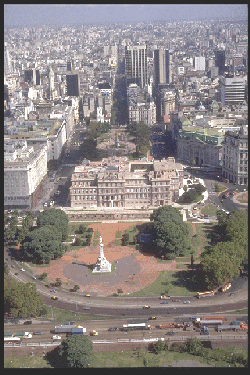
It's true that Argentina is in economic crisis, and the reverberations of the crisis are felt in every place, in every person, in every moment. Foreign visitors will certainly see the eroding effects the crisis has had on local Argentines, but this needn't prevent them from having an enjoyable vacation. For tourists, the advantages of visiting Argentina far outweigh the disadvantages. The advantage is mostly due the the devaluation of the Argentine peso and the fact that the price of food, clothes, taxis and some lodging are one-third or less than what they would be in dollars. Imagine buying a pair of tango shoes for US$20.
Some Safety Precautions
While I recommend visiting Argentina, Buenos Aires is somewhat more dangerous than it used to be. I used to feel fairly safe walking around by myself and waiting for the bus at 3 a.m. on a weekday. Now, I would only do that if I had to because I didn't have taxi money. The streets are a little less safe simply because there are fewer people out late at night, and there are more impoverished and hungry people in the country and in Buenos Aires.Be sensible under these circumstances—don't walk around alone at 3 a.m. For foreigners, taxis are very inexpensive, and taking one to and from destinations is probably the safest route late at night. I have read in the newspapers that there have been situations where passengers have been robbed by taxi drivers and accomplices. However, the number of times I have heard of this happening is minuscule compared to the number of people taking taxis every day and night without problems.
I think that the likelihood of being assaulted or robbed in a taxi scam is very low for most foreign tango tourists with some urban awareness. For example, don't take a taxi sitting outside on the street if you have just walked out of a bank, an American Express office, or any place where you might be getting or changing money. In general, it's best to hail a moving taxi rather than one that's sitting, unless it's a taxi sitting outside a milonga. The milongas have taxi drivers who work for them and those drivers are trustworthy. If you are going out at night from a home, hotel or somewhere where there is a phone, calling a radio taxi is the safest option.
Keep in mind that phones generally are not available for public use in most places. As a tourist, if you use your street smarts and keep a low profile—don't wear fancy jewelry or fur coats, and don't flash wads of cash—then the danger index for you is low. If you're concerned about political uprising—the likelihood of one occurring is very low. At most, you might see some demonstrations. If you do, the best thing to do is stay away from them to avoid any complications. The city is big enough that you should be able to do so.
The Good News
The plus for tourists who visit now is the strength of the dollar. Even though inflation is occurring, prices in Argentine pesos still end up costing less for tourists with U.S. dollars or any currency of similar value. Priced in foreign currency, clothes, restaurants and shoes(!) are all one-third less than what they used to be. From what I can see, tango shoes here are sold in pesos.It seems, however, that tango housing and hotels remain in dollars, but prices are certainly reasonable. You also will be asked to pay in dollars for private tango lessons with many teachers (especially those who are more well-known), and the fee will be the same amount you would pay in the United States. Group classes, however, are priced in Argentine pesos and are extremely inexpensive when compared to those in the United States.
The Effect on the Tango Scene
How has the local tango scene been affected by the crisis? Unemployment, inflation, and the increasing number of people living under the poverty level (at least half the population) will no doubt affect any country's social environment. But in the tango scene and the milongas, the effects are not that obvious. Someone coming here for the first time would never know the difference. Yes, the tango magazines are thinner and harder to come by. Some locals will choose a night or two to go out (probably on the weekend) as opposed to going out every night. But, really, the only locals who ever went out every night anyway were newer dancers in their fanatic stage or people who got free admission. The latter people still get free admission and you'll still see them in the milongas.There are plenty of milongas, and the ones I have attended recently have been very crowded. Some milongas have closed; others have opened—nothing different from the past five years I've lived here. For me, one of the most distressing effects of the economic decline on tango is that many of the best dancers have disappeared from the scene because they have been forced to look for opportunity abroad. But, I find that the level and variety of dancing here is still higher than in most U.S. cities.
Regardless of how many people are in the milongas and what the level of dancing is, Buenos Aires will always remain the heart and soul of the tango. What one experiences here is unparalleled to the tango experience anywhere else in the world. Economic crisis is part of it, and I encourage foreigners to come here and talk to the local people—ask them what is going on and how it is affecting them. In tango's history, Argentina has gone through both good and bad times—all of it reflected in tango's lyrics, music and dance.
*Brooke Burdett is an American and an Argentine tango dancer and instructor who has lived in Buenos Aires for the past five years. You can read more about her and her activities on her webpage.